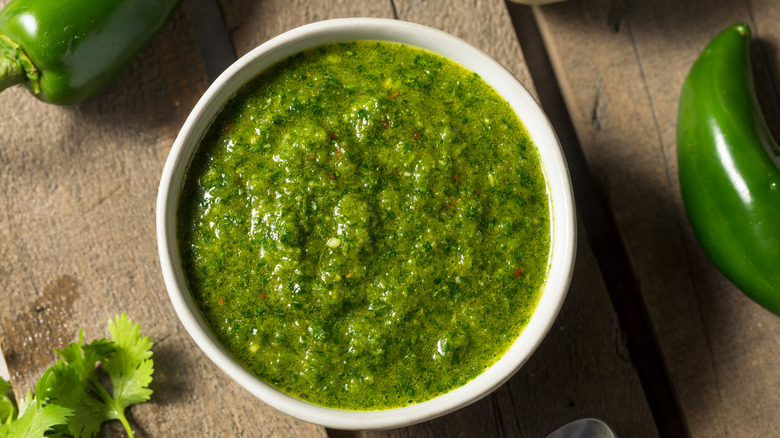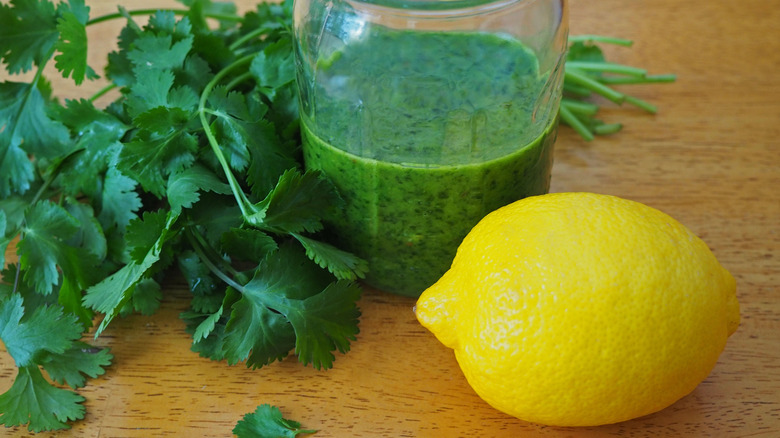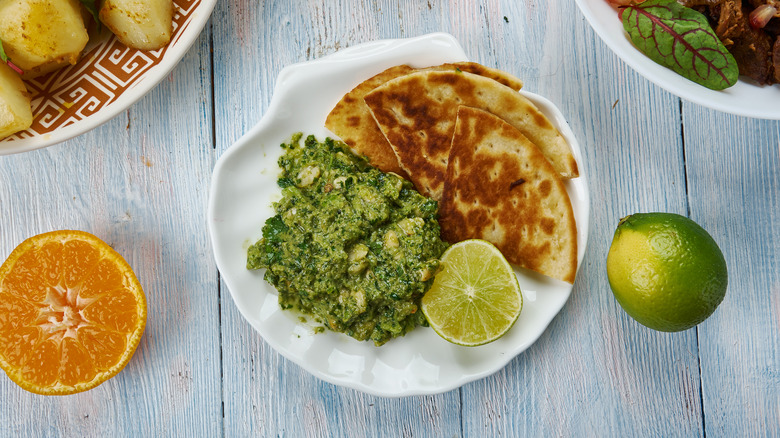Zhoug, The Yemenite Green Sauce With A Spicy Kick
Although hailing from completely separate cuisines, sometimes dishes bear a strong resemblance. Take zhoug, a Yemenite condiment made with cilantro pounded into olive oil. When served in a bowl, it'd be easy to mistake for chimichurri or pesto; instead, it's a distinct zesty creation.
It was first created by Jews who settled in Yemen, and the condiment has now spread across the Middle East and is especially popular in Israel. It's taken on a variety of names, including skhug, sahawiq, and daqqus. No matter what it's called, the sauce boasts a strong flavor that's wondrously versatile.
Crafted with cardamom, cumin, spicy green chiles, and lots of cilantro, it's both savory and bright. Throw it on some eggs or roasted vegetables, and it'll make them pop as a standalone dish. Like a salsa, every rendition is unique, so creating zhoug is always exciting — no wonder it's become a stalwart of Middle Eastern restaurants, including in the U.S. So it begs the question: How does this refreshing and flavorful sauce come together?
How zhoug is made
The paste's bright character rests upon three central components — the herbal element, the spices, and the heat. When it comes to the greens, start with a fresh bunch of cilantro, which is the predominant flavor. Some also integrate parsley, but in smaller proportion, with the green comprising about a ⅓ of the volume.
Preparation starts by toasting the spices in a pan. Cumin and cardamom are the backbone flavors, but they're often expanded with coriander, black peppercorns, and sometimes red chili flakes or caraway. Once slightly browned, throw into a mortar and pestle, and grind by hand to release the most oils.
Next, throw the garlic and peppers into the pulverized mix. In Yemen, the chile variety utilized is called bisbaas, a long and green cultivar that resembles an Anaheim but with more kick. To replicate their spicy flavor, substitute serranos and jalapeños. And if craving even more heat, throw in some dried chile arbols. Continue to pound the mixture for around five minutes until it turns into a thick paste.
Finally, the herbs are introduced in batches. Gradually pounding them necessitates some elbow grease but achieves the most flavorful mixture. Once pulpy in consistency, add a good drizzle of olive oil, along with salt and an optional spritz of lemon juice. It's ready to serve once it reaches a perfect homogeneous consistency. If you're in a hurry, a food processor can cut some time, but the result won't be quite the same.
How to serve zhoug
Much like its cilantro-based cousins, zhoug is wonderfully versatile. In Israel, it's a popular component of mezze platters, served alongside bites like falafel and pita. It can even add another layer to a dip, drizzled atop hummus for a zesty flair. And its herbal flavor is welcomed in a kebab — who doesn't want a bright, pungent hit atop grilled chicken?
Zhoug's flavors pair well with dairy, whether drizzled atop yogurt or alongside a firmer cheese like feta. Thrown in some freshly chopped vegetables and beans, and it's a quick lunch. Like pesto, it'll join varying components and can become the centerpiece, whether it's roasted vegetables and rice or even a salad.
Don't neglect it during breakfast time, either. Drizzled on scrambled eggs, a frittata, or a shakshuka, it'll awaken the palate for a flavorful day. With so many uses, it's definitely worthwhile to craft a large batch. If there is any leftover, no fear — zhoug will store in the fridge for up to a week.


